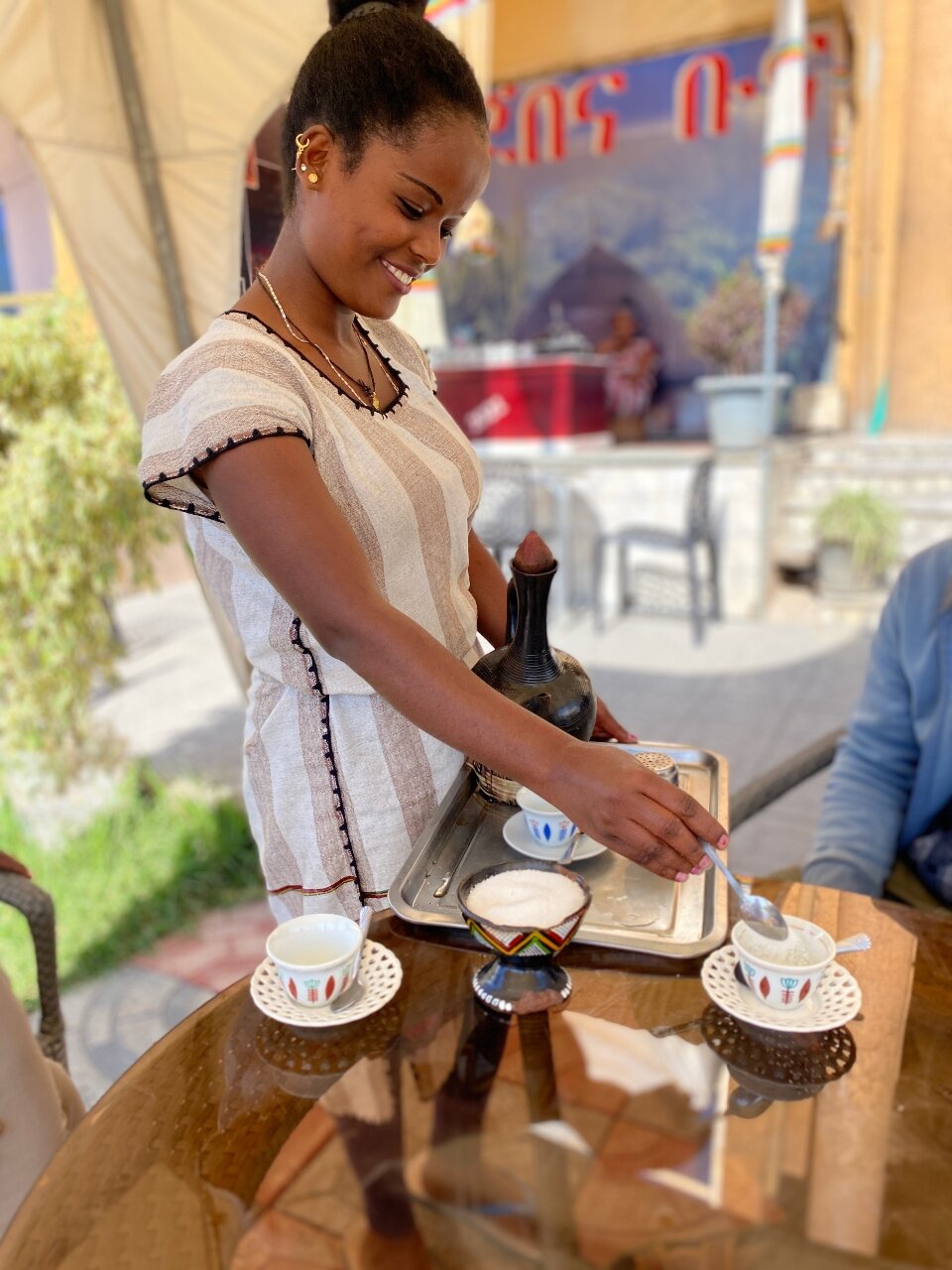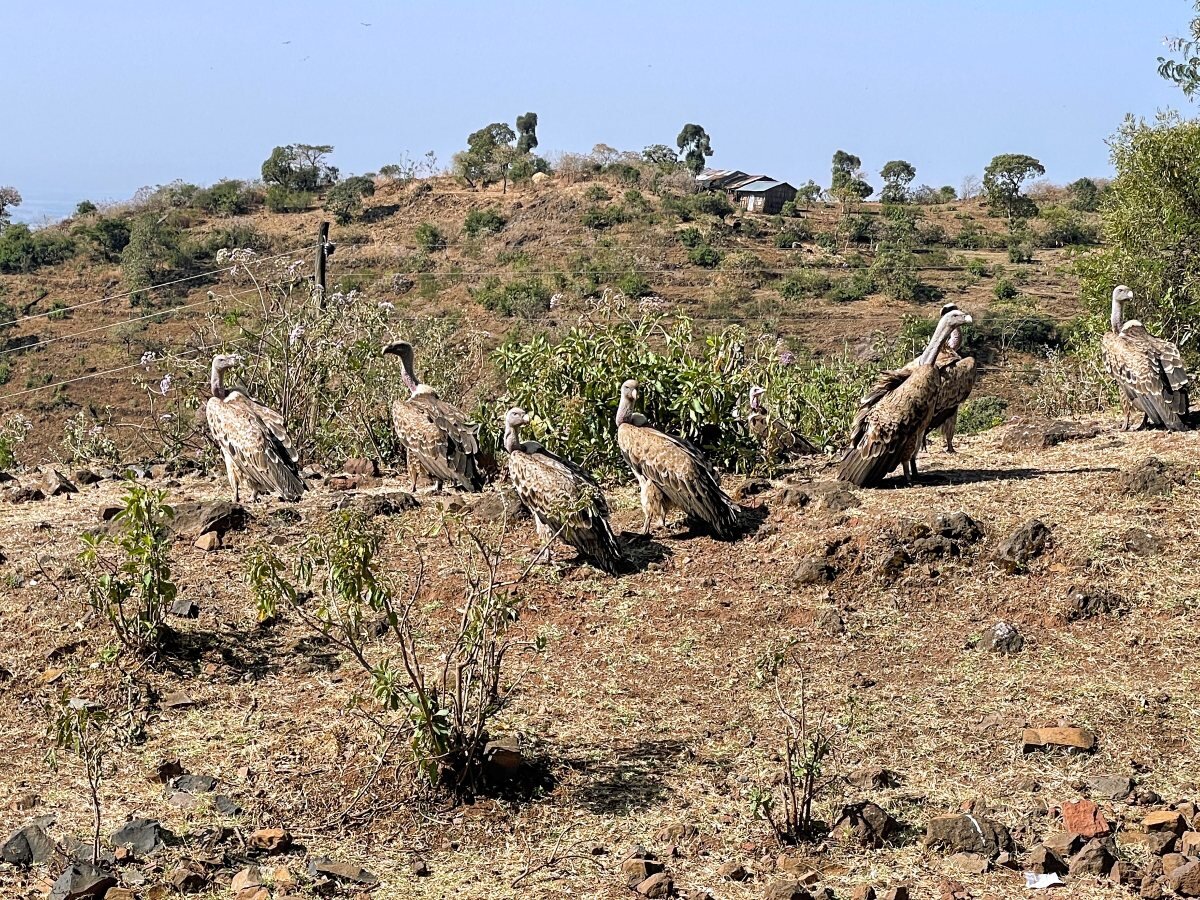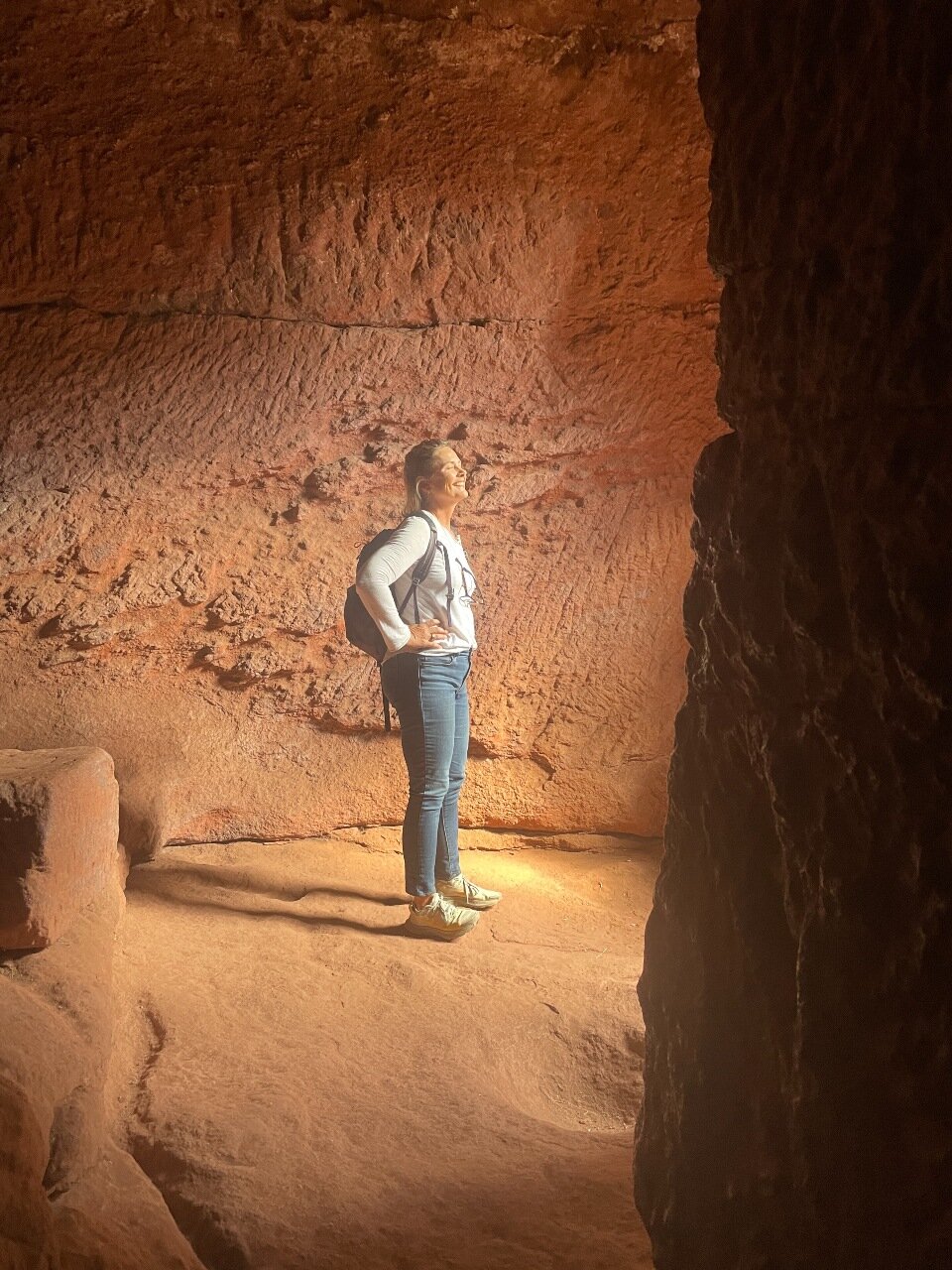HAIL TO ETHIOPIA!
Now for some facts about this fascinating country:
A culturally rich, large and historically significant country. The ancient home of modern man. Archeologists have found human-like fossils dating back 4.2 million years and homo sapiens 200,000 years.
It is deeply religious. Most citizens are Orthodox Christians. Churches, some simple, some dating back 1600 years are everywhere. It is the home of the Ark of the Covenant.
It is the only African country to not be colonized.
English is widely spoken. People are friendly. And coffee is the national drink.
Though it is a poor country. It can be very cheap to travel and eat. But to visit it properly you will need a guide. And that can be somewhat expensive.
Kelly and I started in the south, visiting the tribes of the Omo Valley (see our earlier blog) and then flew to the north. The regions are very different.
But both share some similarities…
COFFEE
Ethiopia and coffee are one and the same. They grow some of the best beans in the world. And what you’ll find is that coffee is almost a religion to them. When you drink it you’ll partake in a coffee ceremony. This happens everywhere. It involves charcoal, incense, fresh cut grass and even popcorn.
The coffee is strong. It’s served in small cups. No milk. Add sugar (though I rarely did)
The ceremony is performed in their houses, on small coffee stands dotting every road you travel on, at hotels and restaurants.
With our guides Fitsum and Isreal we would stop and have coffee every few hours. It is the blood that makes this country work.
FOOD
As for food, Ethiopia is mostly a one trick pony. At least for the locals. It’s all about Injera. It is a sour fermented flatbread with a slightly spongy texture, traditionally made of teff flour — the most common grain grown throughout the country.
It comes on a large plate, on top is a collection of different bean stews (Shiro) and meats (Tibs). Sometimes it’s simple, other times it is a celebration.
You eat it with your hands and share it with whoever you are with. It’s a community experience.
The Ethiopians eat it three times a day and have been doing so for their whole lives.
We liked it a lot, but at the same time, being Americans, we like to mix it up with other foods. Like pizza.
As far as an alcoholic drink, they love their honey wine. Served in a bottle you’d see in a lab, it is a great companion to Injera.
Northern Ethiopia
But once we arrived in the north, we saw that there are also differences too…
Much cooler (in the 70s and 80s), beautiful natural landscape of rolling hills and Acacia trees. People seemed to be better fed, happier and working together on building homes, farming, The north is also much greener, more developed and has much more available water — for agriculture and for people’s everyday needs.
And God is everywhere. In the churches, in the jewelry and in the landscape.
In some ways I wished that we had started in the north, then headed south. I think we would have been more prepared. The south is raw, naked. The north more forgiving.
RELIGION
The tribes in the Omo Valley in the south primarily practice Animism. But in the north it is primarily Orthodox Christian, followed by Muslim. But to an outsider Christianity reigns.
And with that was an amazing collection of churches. From wooden structures filled with scripture based art to the famous rock churches of Lalibela.
It was inspiring to be able to explore these houses of worship.
There are eleven churches carved out of rock. Truly impressive. And still being used for worship today.
JEWELRY
Northern Ethiopia has its unique handcrafted jewelry that can be found near temples and in the markets. Kelly was enamored by their beautiful and unique designs. She started to buy a few pieces for herself, then quickly started to make a gift list. She didn’t stop until her bag was full.
BAHIR DAR
We started our Northern adventure in Bahir Dar. A nice modern town on the shores of Lake Tana. It was fun to explore its restaurants and bars.
Our hotel in Bahir Dar
After I recovered from my hangover, we spent the next day in a boat exploring Lake Tana. It is the source of the Blue Nile, one of the major tributaries of the Nile. It was strange to think that only a few weeks ago we were in Egypt, where this important river emptied into the Mediterranean Sea, 1300 miles away.
Across the lake are a few remote islands, where a few 16th century monasteries stood. Our local guide took us on a hike through the forest. An unassuming round building stood in a clearing.
But once inside, its beauty emerged. So peaceful and quiet. Kelly and I immediately felt a special connection with them. On the walls were the story of christ painted on parchment. It was colorful and well preserved.
The second monastery was equally as nice.
GONDAR
The next day we drove to Gondar — three hours away. Our driver must have been in a hurry as we hung to the railings as he hurled us through the countryside.
Unusual rock formations dot the northern Ethiopian landscape. We saw this on our way to Gondar.
Gondar is the old capital of Ethiopia. It had a bustling downtown, but for the most part we didn’t care much for it. It might be in part because directly across from our hotel was a church that every evening blasted scripture out of speakers for the entire night! Even with earplugs I couldn’t sleep.
We did enjoy our tour of the old walled castle, built by Emperor Fasilides in the 17 century.
We also visited one of the only retangular churches in Ethiopia.
Look below and you can see a huge empty pool. This was built by an early king who wanted a place to chill (literally).
Now, once a year, the city fills it up with water and allows everyone the chance to cool down and play. Now that sounds fun!
Simien Mountain National Park
Certainly one of the highlights of our trip was our visit to the Simien Mountains — only a few hours outside of Gondar. At eleven-thousand feet, you get a chance to get above the valleys and get some otherworldly views.
We stayed at the Simien Lodge, the highest lodge in Africa. A friendly place with very good food. We were alone except a small group of scientists from South Korea. Small world for sure. We enjoyed our evenings drinking wine in front of a fire built to keep the cold temps at bay.
To get into the park, Fitsum (our guide) had to hire a driver, a local guide and a “park ranger” who hauled around a rusty rifle. We all piled into the 4WD and headed deep into the park.
The local guide pointed to a trail which we followed along the upper side of the canyon. Being so far away from everything, surrounded by so much vastness we walked in quiet. It was a feeling that I’d like to keep with me.
Our local guide told me that he takes tourists on 4 or 5 day overnight treks into these mountains. Now that would be something special.
GELADA BABOONS
These creatures are only found in the Ethiopian highlands. Though they are not really baboons. Humans don’t seem to bother them so you can get amazingly close. They graze on all that grass you see here in the pics. As you can see, the males especially are very majestic.
A male Gelada baboon.
At night to avoid predators, they scale down the cliffs and sleep between the rocks. It’s actually steeper than it looks.
These mountains also contain the Walia Ibex. It is rare to see one of these in the wild, but it didn’t stop us from looking. Vertigo anyone?
You never know what you’ll find so far away for civilization.
WEDDING/VILLAGE
We came across a small village near our lodge and decided to stop. It turned out a wedding was in process. So we joined in! Everyone was happy we were there. We all just got together and had a good time!
LALIBELA
Our next stop was Lalibela. A very long eight hour drive away.
Along the way, we stopped and took photos of some Olive monkeys and a few vultures feasting nearby.
Arriving at Sora Lodge in Lalibela was wonderful. Perched on a cliff above a small village, its beautiful rooms and sunset bar were a welcome relief to Kelly and I. We upgraded our room and added a few more days to our stay. We didn’t want to leave.
View from the Sunset Bar. They made a hell of a Negroni.
We also met Jean-Baptiste Huynh who was also staying at the lodge. He is an amazingly talented Paris based photographer who was traveling around Kenya, and now Ethiopia photographing the local people and tribes. You must see his work: jeanbaptistehuynh.com/en/series
We became friends and had some nice drunken dinners together.
As you can see, Ethiopia is a photographers dream — especially portraits. Everywhere you go you find yourself taking once in a lifetime pictures.
The Rock Churches
Lalibela is the most popular tourist spot in Ethiopia. (Not that we saw many. We were pretty much alone.)
You can easily see why. Lalibela is the home to most of the famous Rock Churches. These subterranean monoliths, hewn out of a single rock, are unlike anything I’ve ever seen. Built during the 12th century, they are a true testament to faith.
The church of St. George
A priest studying his bible
The Cave Church
An hour drive away was the church of Yemrehana Krestos, or Cave Church.
No skeletons in the closet here. They kept them in a corner of the cave.
ADDIS ABABA
Our last stop before leaving Ethiopia was where we started. Addis Ababa, the capital of Ethiopia.
The highlight here was to go to the National Museum of Ethiopia where I could see “Lucy” up close.
She of course was an ape-like creature who walked upright and lived in this area 3.5 million years ago. She is considered an important link from early man to homo sapiens.
That just shows you how much history is in this unique country.
ADDITIONAL TRIP NOTES
The things I didn’t know about Ethiopia could fill a book. Here’s my attempt at capturing what caught our eyes:
Even at an airport they use their crazy time system.
For the entire country, the day starts at sunrise and ends sunset. Since the country is located very near the equator, winter and summer are just about equal day lengths. Which means that 6 am equals 1:00. Noon our time is 6:00 their time. And sunset is approximately 12 hours later 6 pm equals 12:00. Confused? So were we.
Over 45 different languages are spoken within Ethiopia. Luckily for us, many speak English.
Their calendar contains 13 months. The 13th month captures the ‘forgotten days’ in leap year and contains 5 or 6 days.
Toilet paper is mostly not available except in hotels and touristy restaurants. If there’s running water, you’ll often find a spray nozzle near the toilet to be used in lieu of toilet paper. When there’s only a concrete hole in the floor, there’s often a bucket of water and a pitcher to be used to flush.
Very few Ethiopians own cars. Most ride donkeys or, if they have money, the can hire a “bajajs” (tuk tuk) to get around.
The bigger hotels will take a credit card but the rest of the country is cash only.
We noticed very few people smoke cigarettes.
During our month-long visit, most of the country was observing lent, so many of the restaurants served only vegan meals. Also pork is rarely eaten.
ON A PERSONAL NOTE…
I would like to add that traveling with Fitsum Ashebir (and Israel Legesse our driver through the southern region) the owner of Omo Valley Tours was definitely the best thing we could have done. Fitsum truly gave us an objective introduction to his world. And took care of us in so many ways.
We will be friends forever.




















































































